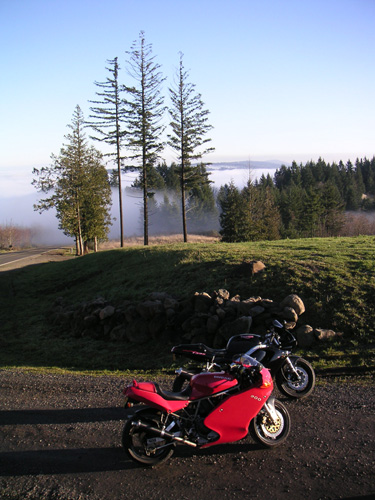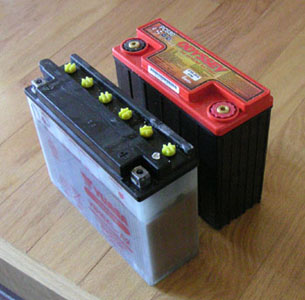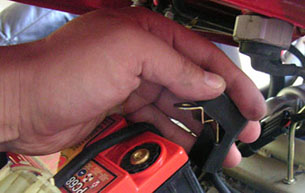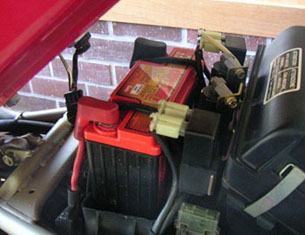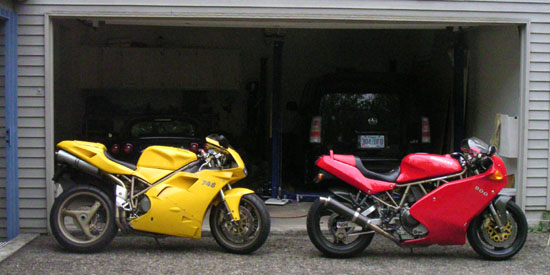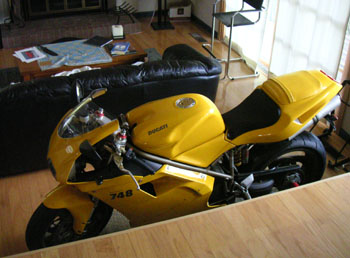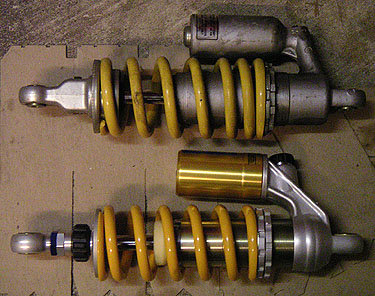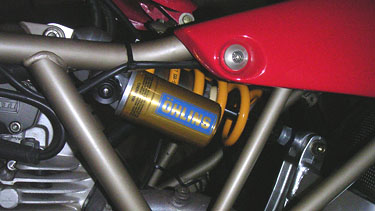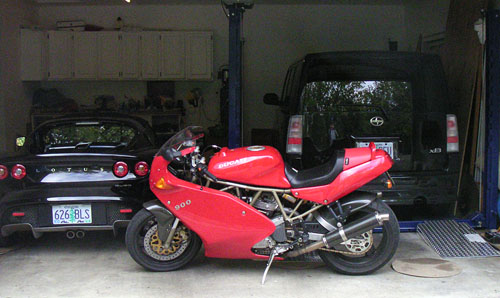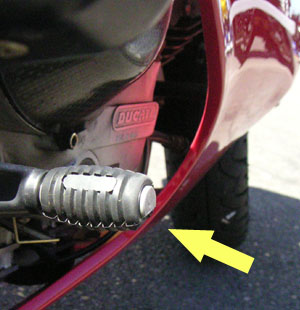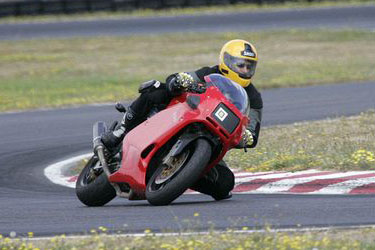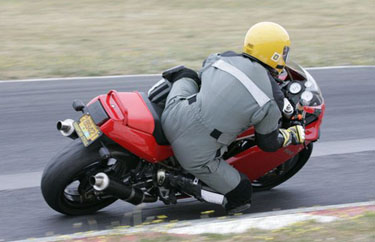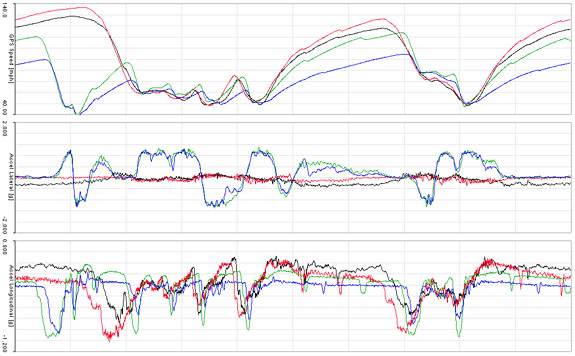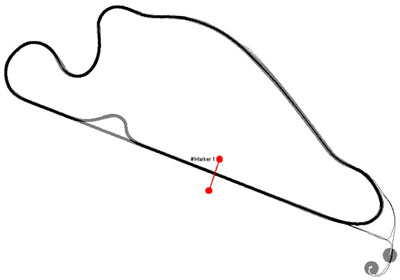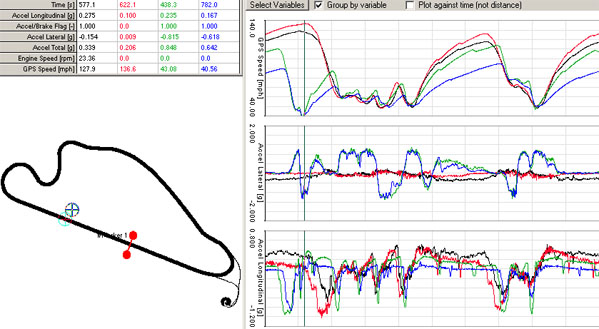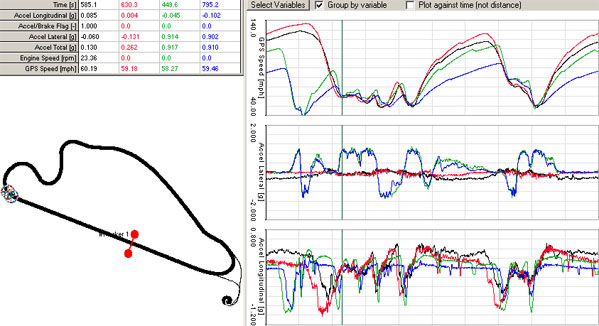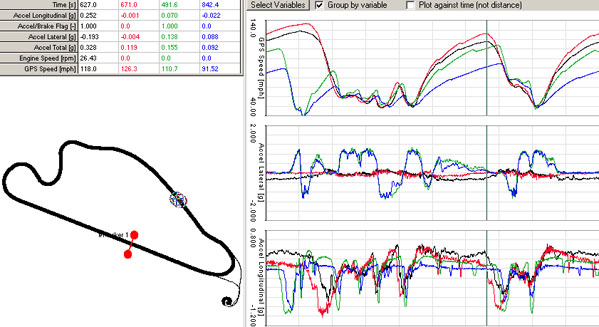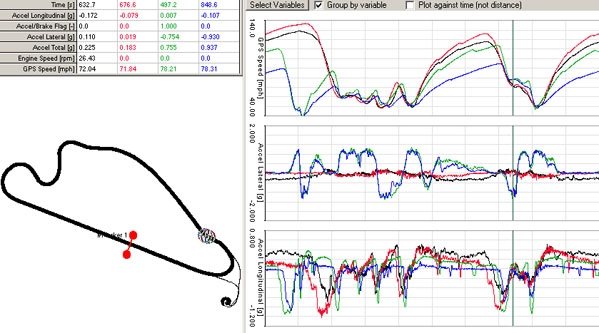|
12/23/04 "Thursday should be sunny, so let's go riding" - that was my friend David's idea. I had already been thinking about it anyway (had promised a ride to someone) so the plan was hatched. Except that Tuesday and Wednesday it rained, instead of the promised 'partly cloudy'. Thursday came around shrouded in near-freezing fog but later in the day a couple of rays of sunshine did break through the all-enveloping greyness. Earlier in the day I had taken the Elise along our intended route to 'pre-run' it, finding mostly wet pavement and fog... But a plan is a plan, so we and our respective passengers gathered at my house in the early afternoon. A lengthy procedure to put on the multiple layers of sweaters and protective gear, then an almost equally lengthy ordeal to wake the Duck and its chokeless flatslide carbs from the four-month slumber. Then we head out. It's cold. About 40 degrees F. First-time passengers can be a bit of a challenge in that they tend to shift around and cause the bike to move a bit in turns. After a short initial period of slight unease either comfort or cold sets in and the passenger-induced wobble goes away. The ride however remains a challenge, especially once we get to the upper reaches of Skyline. We are rolling through the clouds, visibility sometimes goes to a couple hundred feet, the helmet visor fogs over instantly and then the road turns into the sun breaking through the fog... It can be quite a shock to find oneself flying a motorcycle in IFR (that's zero visibility for non-pilots). OK, so much for using the visor... Once adapted to the atmospheric peculiarities the experience is actually quite fun, albeit in a slightly masochistic way. The views above the cloud line are amazing, as are the long beams of light slicing through the upper layers of the fog when we're in it. We only stop for pictures once but this gives a general idea (click the picture for larger version and see where the road on the left enters a wall of fog). Progress is of course very moderate given the circumstances but this ride isn't about tearing up the corners (we still manage a little of that, but nothing too radical) - it's about riding motorcycles in late December in Portland. Just because we can. Definitely a memorable outing and that's what it's all about. 07/31/05 Battery replacement time. The batteries in the Ducatis have been giving me all kinds of problems, primarily due to infrequent use. I don't like riding on the street and only do a handful of trackdays each year, so each bike gets used maybe a half-dozen times in a 12 month period. I've ridden the 900 only a couple of times since the last update, some 9 months ago. I do trickle-charge the batteries periodically but they just don't hold up, plus the high compression and flatslide chokeless carbs on the 900 make starting it a real adventure. It's a handy thing I live on a fairly long hill, but I've pushed my luck with that on a few occasions! So I did some research and came up with Odyssey PC-680 drycell battery as the most fitting replacement (there is also an MJ version of it with a metal jacket around the outside, however it makes the battery a bit wider still and that would make it a problematic fit). It has excellent cold-cranking capacity (680 amps supposedly, hence the name) and is designed to be quite tolerant of deep-discharge. So I ordered three of them from West Coast Batteries - one for the 900, one for the 748 and one for the dp1. The Odyssey is a little shorter, a little wider and maybe a pound heavier than the OEM battery.
On the plus side it doesn't vent acid over the bottom of the engine cases and of course has all the other advantages to boot so I'm happy to pay the weight penalty. In the 900 the install is very straightforward, the only tweak necessary being the straightening of a couple bends in the battery connectors - a two-minute job with pliers.
So now I just need to go ride this beast every now and then. Maybe once the current heatwave subsides a bit I'll take it out to get fluids circulated. One potential problem is that the clutch has been sticking oddly - it only does it when the engine is running and only sometimes even then, so it's hard to diagnose. I bought a replacement master cylinder (the slave had been replaced recently) but haven't installed it yet. I guess a bit of riding will be a good way to try and find what's really wrong here. 08/10/05 A nice overcast day and way too much time in front of a computer lately, so I finally decided to roll the 900 out. The new battery is thankfully up to the task of getting it started, though the procedure does take a while. Modern injected motors are just so much more user friendly... but in some ways, the fussiness of the flatslides just adds to the character. Given how infrequently I use this bike the ritual is almost appropriate somehow. If I had to ride it daily I'm sure I'd feel otherwise! I've mentioned it before, but the 900 is a very different beast from the 748. It is also the longest-owned vehicle I've ever had, by far - next spring will be ten years. I doubt I'll ever sell it. This is not a sentimental statement but more a matter of the fact that given the choice between having the bike and whatever money I could get for it, which isn't much, I'd rather have the bike.
I rode it just briefly, on my favorite local road, which is about a 15-minute round trip. Then I decided that the next trackday I'll do on this one so the 748 went into the livingroom for now. I'm so used to having a red bike there that a yellow one really looks odd.
I'm sure I'll get used to it. This winter the yellow and red Ducks will be joined in the livingroom by a silver one. Bikes are just so much easier to 'collect' than cars. Very low impact on resources - be it money, storage space or time. Yet taken in small doses, when the conditions and the mood are just right, the fun they deliver is unmatched. Works for me. 08/17/05 For quite some time now I've been wanting to raise the rear ride height on the 900. This stems from a number of things, all originating with the bike's reluctance to turn in as-delivered form. Early on I did two things to drop the front end - slid the forks up 1/2" and switched to a 60-series front tire. This, besides making the speedo read way too high, did make the steering much quicker. Unfortunately it also lowered the bike so much that it would no longer lean over on its sidestand. I bent and ground down the stand as much as practical but even so parking it has always been a precarious affair. Another side effect was that it got too easy to drag the headers (the fact directly responsible for me dropping the bike on its 1,000th mile, even before its license plates arrived) so I fixed that by having 1" cut out on each side and re-welded. By now you must be thinking "what a backwards way to go about things, why not just get an adjustable rear shock?". Well, all I can say is that I don't always act rationally. Plus hey, it was nearly 10 years ago and I was young and stupid. So what's changed, right? Well, I finally decided to get a rear shock. Better late than never, and besides the current one with 10K miles on it hasn't been working too well anyway - for some time there has been a wobble in the back after each transition and playing with adjustments didn't seem to help much. So, the shock. I'd like an Ohlins, but they're pricey - about $800. A Fox at around $600 seemed more reasonable so I did a bunch of searching online. At which point I stumbled onto an Ohlins at $616 from an online vendor who shall remain nameless (you'll see why). The problem was they only listed it for '99 and later 900SS, when Ducati completely changed the bike (styling, chassis, motor - everything). So I call them up - will it fit a '96? - No, came the reply after some time on hold. Do you have one that would fit? No. Bummer. On to Ohlins website - the same shock, DU235, is listed for the '96 as '99-on. Ohhhkay.... Checked the overall length dimension - identical at 328 mm (the Ohlins is length-adjustable, this is how I intend to change the ride height). So I decide to take a chance and call the vendor again. So you want to order one? Yes. Ok, it's $775 plus shipping. Wait, your site says $616. Nope, that's wrong, you can't buy it for that, it's an $800 shock. Ehhh, thanks. Click. Two hours later I get to wondering - what if?... So I go and order the thing online. Yep, $616. Order processed. We'll just have to see what happens I guess. That was last Friday. Amazingly, today a shiny new shock shows up and my credit card gets billed the proper amount. Ah, so indeed I CAN buy it for that! As I've often found, it pays not to take people's word for things. The install is really straightforward and took less than 1/2 hour. The bike was hung from the lift to unload the shock...
The old shock came out painlessly, just 2 bolts. Here's old vs new, looks good so far...
The new one goes in perfectly and fits just right. I decided to increase the shock length 1/4" over stock which picks up the back end 1/2" overall. This can be adjusted later if need be.
Back off the lift the bike now sits noticeably taller in the back and leans much more solidly on its sidestand. Just right in fact. A quick test ride on my favorite road reveals more solid and controlled handling, with the uneasy wobble completely gone. Cool. Tomorrow is a track day so we'll see how all this works at speed. I'll probably play with settings some. Right now it's 4 clicks from full hard, which is firm but not harsh. Even looking at the bike parked it has a more nose-down, tail-up stance which looks a bit more aggressive to me. Or maybe I'm just seeing things.
Anyway, I'm happy. 08/18/05 Finally another trackday for the 900. It's an interesting contrast to the 748 on the track - more raw, less top end power but more low-down torque. It gets up to an indicated 145mph which as far as I can figure is about 125mph in reality, whereas the 748 is about 20 mph faster. Of course everyone blows by on the front straight (with the back straight actually being a curve, a lot fewer people are able to go flat-out there). So I have to gain back the ground in the twisty parts. Good thing we are allowed to pass in turns on bike days! Another difference between the two machines is ground clearance when cornering. On the 748 I don't think it's possible to drag anything except maybe if running race slicks. This one is a different story. Even with the raised suspension I was repeatedly grinding the foot brake lever..
I might need to look into adjusting it to sit a bit higher. But if you look at the picture on the right, the next thing to touch down after the brake lever will be the pipe and I don't want that. Perhaps the lever serves as a useful 'curb feeler' afterall. So basically I had to get myself to hang off more to keep the bike more upright and that's what I worked on most of the day, with some success (images below copyright Tranquil Velocity)
Also, I have finally managed to position the knee sliders so that I'm using the face and not just the edge. Now that I'm leaning on them a bit I've decided I don't really care for the leather sliders. Yeah, it's a smooth feel but it's a bit too draggy for my tastes. I'll have to try a set of regular plastic ones soon. The next trackday, it might be interesting to run the 748 halfday and the 900 the other half, for a more direct comparison. Hopefully I'll have functional video and/or GPS by then so I can get some lap times too. We'll see. 09/19/05 Now that I have some GPS data for the bikes, some light can be shed on the oft-asked question of car-vs-bike - which is faster? First, a bit of background. The driver/rider is a huge part of the equation (see also today's entry on the 748 page). I'm basically an advanced trackday driver - not at pro level by any means, although now that we can easily get data it will be interesting to quantify just how close/far I am. Fortunately there are some pro-level drivers around these parts. But overall I feel that I can extract close to 99% performance from a production car on street or R tires, given some seat time in the car and familiarity with the track. Both data and lap time comparisons with other drivers back this up. Of course a pro can jump in a car he's never driven and be near peak efficiency in a few laps whereas it takes me one or two full trackdays to get there. On bikes I'm a couple notches below that level, I think that only recently did I get around 90% performance on my Ducatis and a bike like the R1 is still way too much for me. Today I'd guess I was running at over 95% in the corners but at best 90% in terms of getting the drive out of the corner and no better than 85% in the braking department - so let's call that 90% overall. As for the vehicles themselves, the two cars - Elise and Scion - are on nearly identical tires, both 280 treadwear high performance street rubber. Relatively speaking, the tires on the bikes are a bit stickier, probably the rough equivalent of something like 140 treadwear for cars. Other variables, like track familiarity and track conditions are not a factor since the operator is the same in all cases and all data was taken on very similar days - dry, sunny, around 70-75 degrees. One major difference is that cars run the chicane and bikes don't, therefore lap times are not directly comparable but the GPS allows corner-by-corner comparison. So, all that being out of the way, on to the data. The first two pictures show the complete trace overlay and the track map, with chicane and without.
The respective traces are 900, 748, Elise, Scion. Looking at the speeds in the chicane area (top set of traces) it's easy to see why the chicane is worth 10 seconds. While bikes are hitting their top speeds of 137 and 128 mph, the cars are sliding through the chicane at about 40 - see below.
The next point of interest is the entry to turn 4 (I'm going to use the 'car' turn numbers where chicane is turns 1-2-3). Notice that in cars I leave the braking a lot later. If you look on the 748 page where I had an experienced rider take my bike for a few laps, you'll see that he also brakes later there than I do. This is an illustration of the progression of driver/rider skill. I remember a couple years back in cars I had reached a plateau in terms of lap times and the breakthrough, when it came, was learning to use the brakes. On bikes I'm at this transition stage right now - I'm getting better but still braking way too early and in some cases too hard. It's a psychological thing - seeing that turn flying towards you at nearly 140 mph is intimidating and I haven't gotten over that yet, mostly because I don't yet have the confidence in my ability to control braking precisely.
On the 748 in particular, where I'm braking from 139 mph at 1g and trying to downshift 3 gears at the same time it's just a bit much so I leave myself some extra room, which of course costs me time. Look at the corner entry speeds for the four machines in the picture above though - they are all within 1 mph of each other, at around 60. Another interesting tidbit is that both cars are at almost identical 0.9g lateral while the bikes of course have virtually zero lateral g due to lean. Through the esses the notable thing is that in the Elise I'm able to accelerate in between turns and generally carry a couple mph higher corner speed. In the Box I don't accelerate between turns just because there's no power (it only has 10 hp more than the 748 while weighing 2,500 lbs vs 450). On bikes I don't accelerate because I'm not up to it yet. This is where the more experienced rider on my 748 was making most of the time, by getting a better drive out of the corners. In my experience it's the third stage of driver progression - maximising acceleration time, always being as hard on the throttle as the tires will allow and then some. In cars I'm working on this now, with some success as the Elise trace shows. On bikes I'm just beginning to do that (again see 748 page), with very controlled throttle roll-on. It's a gradual process since the price for jumping too far out of my comfort zone could be pretty high. The next interesting spot is the back straight, just before turn 10. Again you can see how much later I brake in the elise than on bikes. It also illustrates the accelerative advantage of bikes and shows where they gain time on cars (and also shows why getting a good drive out of a corner is so important - accelerate harder sooner and carry more speed down the straight). Here it is obvious why the Box gets by far the slowest lap times of the bunch.
The 748 carries the highest speed there, 126.3 mph, while the Box is at 91 mph laboring towards an eventual peak of 94. Turn 10 itself is a very interesting case. It's a much faster turn than it looks and this is where I gain a lot of time on most people, both in cars and on bikes. Notice however that corner speeds on four wheels are quite a bit higher than on two, an identical 78 mph for Elise and Box vs equally identical 72 mph for the Ducs.
The Box, interestingly, carries the most lateral g in that spot - 0.93 vs 0.75 for the Elise. This tells me that in the Box I'm getting the most of the car while the Elise could do better there if the driver were up to it. Likewise, since the bikes matched car cornering speeds through earlier parts of the track it stands to reason that they can do it here too, if the rider would let them. Picking up another 6 mph through that section would definitely help my bike lap times. Curiously, when Michael rode the 748 he did not go any faster through 10 than I did. Of course he only did a dozen laps and he was being relatively conservative due to it not being his bike. Still, he was rather surprised when I showed him that the Scion was 6 mph faster through 10-11 than him on the Ducati! :) GPS is indeed a fascinating tool. Looking at the data has already helped me quite a bit in both cars and on bikes - after seeing what exactly I was doing and where, then being able to compare that to what some experienced drivers/riders were doing in the same places, I was able to drop my Elise time by 1.5 seconds, Box time by 1 second and 748 time by 1 second. It also showed that I still have room for improvement although in the Box it will be the hardest to make further gains, just because I'm using it better than the other vehicles. Fun stuff. So, what the data shows is that at least when looking at production cars and bikes on high-performance street tires, bikes have the potential to be significantly faster. They can match car corner speeds, have similar or better braking performance and a huge acceleration advantage. The catch is that it's a lot harder to be fast on a bike than in a car, partly due to psychological effects (also known as fear ;) and partly because it's just a much more physical activity requiring a higher degree of athleticism and precision. Therefore in the real world most people will be faster in cars (I'm not including actual racers in 'most people' - just normal enthusiasts who do a few trackdays a year and on down). For me personally, the Elise has been the fastest among my current stable but now I think the 748 edged it out, finally - and will continue to get faster from here. On the 900 I'm still trailing the Elise by maybe a second per lap. The Box is of course much slower than the rest due to power deficiency. In terms of raw lap times for the 900, my best for the day was 1:24.9 - not bad for a 10-year-old bike with 70 hp, though of course as the data shows the bike can do better. In my hands the 748 was over two seconds faster at 1:22.3 with the time being made up on the straights. Michael took it around in 1:19.9 which confirms my earlier contention that I should eventually be able to match and exceed my R1 lap times on the 748. It's a fun goal to chase. The GPS datalogger I've been using is the DL-1 from Race Technology. It's a pretty neat device and relatively inexpensive, too. Comparable to the price of a Ducati exhaust upgrade and as such I think it's a much better performance gain for the money - an exhaust won't shave a second off your lap time :) |
